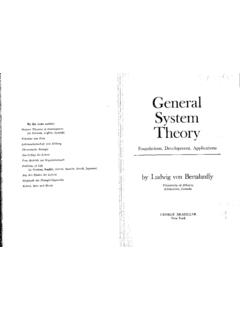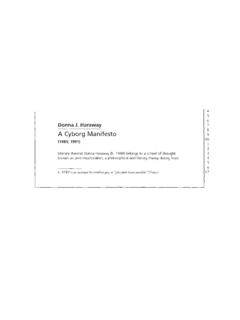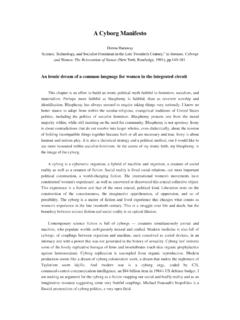Transcription of What is Democratic Consolidation?
1 Journal of Democracy (1998) 91-107 what is Democratic consolidation ? Andreas Schedler During the past quarter-century, the "third wave" of global demo-cratization has brought morethan 60 countries around the world from authoritarian rule toward some kind of democraticregime. 1 This is no small achievement, of course, but it has also become apparent that sustainingdemocracy is often a task as difficult as establishing it. In the immediate aftermath of all thesedemocratic transitions, pressing concerns have quickly arisen about how to strengthen andstabilize these new regimes. With the extension of democracy to additional countries now havingslowed, political scientists--and political actors in new democracies--have been increasinglyfocusing on what has come to be called " Democratic consolidation ." Originally, the term " Democratic consolidation " was meant to describe the challenge of makingnew democracies secure, of extending their life expectancy beyond the short term, of makingthem immune against the threat of authoritarian regression, of building dams against eventual"reverse waves.
2 " To this original mission of rendering democracy "the only game in town,"countless other tasks have been added. As a result, the list of "problems of democraticconsolidation" (as well as the corresponding list of "conditions of Democratic consolidation ") hasexpanded beyond all recognition. It has come to include such divergent items as popularlegitimation, the diffusion of Democratic values, the neutralization of antisystem actors, civiliansupremacy over the military, the [End Page 91] elimination of authoritarian enclaves, partybuilding, the organization of functional interests, the stabilization of electoral rules, theroutinization of politics, the decentralization of state power, the introduction of mechanisms ofdirect democracy, judicial reform, the alleviation of poverty, and economic stabilization. At this point, with people using the concept any way they like, nobody can be sure what it meansto others, but all maintain the illusion of speaking to one another in some comprehensible " Democratic consolidation " may have been a nebulous concept since its very inception, theconceptual fog that veils the term has only become thicker and thicker the more it has spreadthrough the academic as well as the political world.
3 If it is true that "[n]o scientific field canadvance far if the participants do not share a common understanding of key terms in the field," 2then the study of Democratic consolidation , at its current state of conceptual confusion, iscondemned to stagnation. The aspiring subdiscipline of "consolidology" is anchored in anunclear, inconsistent, and unbounded concept , and thus is not anchored at all, but drifting inmurky waters. The use of one and the same term for vastly different things only simulates ashared common language; in fact, the reigning conceptual disorder is acting as a powerful barrierto scholarly communication, theory building, and the accumulation of knowledge. I believe that we can order and comprehend the multiple usages and meanings of "democraticconsolidation" by looking at the concrete realities as well as the practical tasks the term is meantto address.
4 The meaning that we ascribe to the notion of Democratic consolidation depends onwhere we stand (our empirical viewpoints) and where we aim to reach (our normative horizons).It varies according to the contexts and the goals we have in mind. Viewpoints and Horizons When students of democratization seek to classify regimes, the key distinction, of course, runsbetween those that are Democratic and those that are not (the latter often generically labeled as"authoritarian"). The most widely accepted criteria for identi-fying a country as Democratic havebeen put forward by Robert Dahl--civil and political rights plus fair, competitive, and inclusiveelections. 3 Dahl calls countries that meet these criteria "polyarchies," but they are morecommonly referred to as "liberal democracies." Two other subtypes of democracy have gained wide recognition in the scholarly literature onnew democracies.
5 On the one hand, there are all those borderline cases that possess some but notall of liberal [End Page 92] democracy's essential features, and therefore fall somewhere inbetween democracy and authoritarianism. I call such semidemocratic regimes "electoraldemocracies." This term is now generally used to describe a specific type of semidemocracy--one that manages to hold (more or less) inclusive, clean, and competitive elections but fails touphold the political and civil freedoms essential for liberal democracy. Here, however, I will usethe term "electoral democracy" more broadly as a convenient shorthand for any kind of"diminished subtype" of democracy. 4 On the other hand, there are those "advanced democracies" that presumptively possess somepositive traits over and above the minimal defining criteria of liberal democracy, and thereforerank higher in terms of Democratic quality than many new democracies.
6 This term risksidealizing and reifying the wealthy Western democracies, but even if we recognize that admiringreferences to "established Western democracies" often rely on stereotypes, we have toacknowledge that discursive constructs (such as " Democratic normality") are social realities too. This four-fold classification--authoritarianism, electoral democracy, liberal democracy, advanceddemocracy--basically corresponds to the way David Collier and Steven Levitsky have orderedthe semantic universe of democracy and its subtypes. In their admirable effort to bring order tothe chaos of innumerable subtypes of democracy that circulate in contemporary democratizationstudies (they stopped counting at 550), they have distinguished precisely these four broad regimecategories (even if they label them differently). 5 I want to show that these broad categories alsoprovide a basis for reordering the conceptual map of consolidation studies, and forcomprehending the manifold ways students of democracy use the term "democraticconsolidation.
7 " Figure 1 presents this classification of regime families graph-ically along a one-dimensionalcontinuum of "democraticness," with authoritarian regimes placed at one end and advanceddemocracies at the other. 6 It depicts in a graphical way how these four regime types define theempirical contexts as well as the normative horizons and practical tasks that characterize distinctconceptualizations of Democratic consolidation . The two middle categories, electoral and liberaldemocracy, represent the empirical referents of all debate on Democratic consolidation . Innormative terms, authoritarianism forms the outer negative horizon that democrats in both thesekinds of regimes try to avoid, and advanced democracy forms the outer positive horizon that theytry to approach. In addition, electoral democracy and liberal democracy constitute normativehorizons for each other. While electoral democracy appears as liberal democracy's proximate[End Page 93] horizon of avoidance, liberal democracy appears as electoral democracy'sproximate horizon of attainment.
8 Now, those scholars who look (fearfully) from electoral or liberal democracy to authoritarianismequate Democratic consolidation with avoiding an authoritarian regression, a "quick death" ofdemocracy. Those who look (hopefully) from electoral or liberal democracy to advanceddemocracy equate Democratic consolidation with Democratic deepening, with advances in thequality of democracy. Those who look (with concern) from liberal democracy to electoraldemocracy equate Democratic consolidation with avoiding a "slow death" of democracy, theerosion of certain funda-mental Democratic features. And those who look (with impatience) fromelectoral democracy to liberal democracy equate Democratic consolidation with completingdemocracy, with supplying its missing features. We might say, tentatively, that those who are concerned with Democratic stability and try toavoid regressions to either [End Page 94] nondemocratic or semidemocratic regimes support"negative" notions of Democratic consolidation , while those who are concerned with democraticadvances and try to attain progress toward either liberal or high-quality democracy sponsor"positive" notions of Democratic consolidation .
9 7 In a way, this contextual and perspective-dependent approach tries to reconstruct the concept 'steleological core. Of course, I am not the first to note the teleological quality of democraticconsolidation. Both Ben Schneider and Guillermo O'Donnell have repeatedly criticized thenotion's "strong teleological flavor." 8 These critics are right. Democratic consolidation is indeedan intrinsically teleological concept . Yet I think there is nothing inherently wrong with teleology ,provided that three conditions are met: First, we have to avoid veiling or obscuring it; hiddenteleology is indeed bad teleology . Second, we have to dissociate teleology from any belief ininevitable progress: supporting some telos, some normative goal or practical task, is one matter;assuming "some kind of automatic or 'natural' progression" toward that goal is quite another. 9 Third, we have to acknowledge that the notion of Democratic consolidation knows not merelyone characteristic telos but many, and that this plurality of teloi accordingly defines a plurality ofconcepts of Democratic consolidation .
10 Avoiding Democratic Breakdown Once a transition from authoritarian rule in a given country has reached a point where (more orless) free, fair, and competitive elections are held, Democratic actors usually cannot afford torelax and enjoy the "bounded uncertainty" of Democratic rule. More often than not, regime-threatening "unbounded uncertainties" persist, and the democrats' fundamental concern shiftsfrom establishing democracy's core institutions to securing what they have achieved. For theseactors, consolidating democracy means reducing the probability of its breakdown to the pointwhere they can feel reasonably confident that democracy will persist in the near (and not-so-near) future. This preoccupation with regime survival describes the "classical" meaning ofdemocratic consolidation . It gives coherence to a broad and crowded semantic field where a widerange of semantic labels defines this telos in either positive or negative ways.









